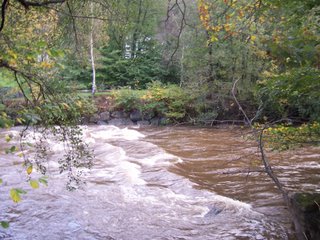The Joys of Lowland Farming
 Ynysarwed farm today
Ynysarwed farm todayBack before the Second World War, in 1937, my sister and brother – in – law, Ruby and David William Reynolds returned from London to Ynysarwed farm when Mrs Richards (Will’s adoptive mother) died .Mr and Mrs Richards had reared Will since he was two months old, following his mother’s death from typhoid fever. They returned to work the farm and care for Mr Dan Richards a well-known forestry haulier who owned two magnificent shire horses. A year later, I, Josie (Oaten) Duke joined them , to help when my sister was taken ill , and stay
 ed for a year or so. This leads into my story of difficult times in farming.
ed for a year or so. This leads into my story of difficult times in farming.The river Neath (Afon Nedd) , October 2005, in full spate notice the embankment built to raise the banks of the river and prevent it from invading its floodplain.
Twice yearly, sometimes more, the middle of the valley would be flooded due to torrential rain both locally and further up the valley, this was made worse by the blocked up arches of the Ynsybwllog aqueduct and meant that the whole farm was under water. William Davy (as he was known), Dan and the farm hands would be out in their waders and as many waterproofs as possible, battening down and tending to the animals, getting them to the highest places. Tiny chicks would even be taken upstairs in the house. Everyone was aware at all times of the danger of being knocked over by the strong currents, which lasted for hours.
The pigs in their sties, when the floods were at their worst would be up on their hind trotters with their front trotters resting on the gate tops above the water, squealing with fright. The only way in and out of the farm was on the back of shire horses.

The Vale of Neath – a classic glaciated valley with steep sides and flat bottom of poorly draining boulder clay. Notice the new A465 road is buit on an embankment because of the danger of flooding.
In the house, which would also be flooded, it would be time to move fast once water started trickling through the back of the kitchen fireplace. Rugs and carpet were lifted, movable furniture taken upstairs, heavy cupboards were emptied and lighter furniture was stacked on top. The baby grand piano’s legs were put in Wellington boots on top of blocks. Finally, food was taken upstairs. Despite the fact that some of this work had been done in advance it was still no mean task.
We would watch from the bedroom windows as the water rose to the level of the teeth of the horse drawn mower parked at the front of the house. Floating by would be all manner of debris – huge logs, tree branches, barrels, bins, literally anything that was floatable. Even chickens were swept rapidly along by the current. The worst time was at night, when the only lights were storm lanterns outside, oil lamps and candles inside.
There were huge sighs of relief by us all when the water started going down tooth by tooth on the mower at the side of the house. The water level inside would rise to a height of about two feet depending on the severity of the flood. As the water receded it was brush and shovel time in the house, one of us at the front door and another at the back furiously brushing the water out. It was important to keep the water swirling, taking the silt and the abundance of small coal with it from further up the valley.
Our next job was to re-light the fires to boil gallons of water for the purpose of scrubbing. The walls up to three feet, cupboards inside and out, flagstone floors and chairs had to be scrubbed over and over again. This took many hours whilst the men battled by brushing and shovelling the farm buildings, machinery and yards. This was a very worrying and traumatic time; the drying period took literally weeks.
This went on for many years despite trying to divert the river with old coal drams filled with rocks and pleading with the relevant authorities for help, all to no avail. Very many years later, the riverbed was dredged and the arches at Ynysbwllog aqueduct cleared. However, before this my sister and brother-in-law had had enough of this slavery and decided to move on the death of Dan Richards. The best thing they ever did.
The memories of those years will live with me and with their daughter Joan, forever.
Josie Duke

